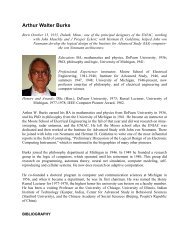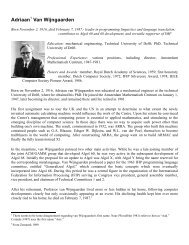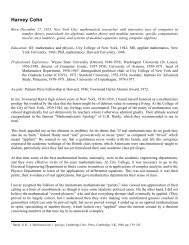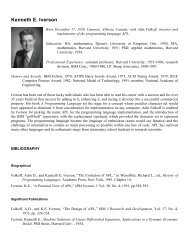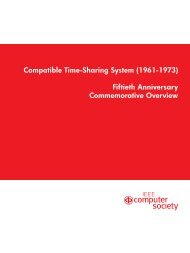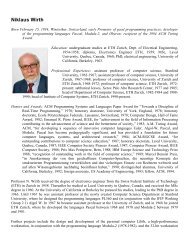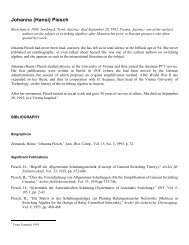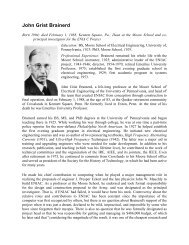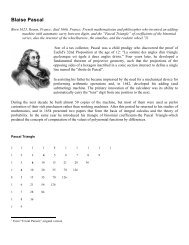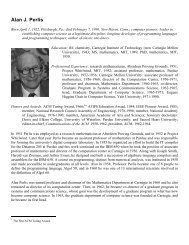Writing a Big Book -- A First Experience with LaTeX - Walden-family ...
Writing a Big Book -- A First Experience with LaTeX - Walden-family ...
Writing a Big Book -- A First Experience with LaTeX - Walden-family ...
Create successful ePaper yourself
Turn your PDF publications into a flip-book with our unique Google optimized e-Paper software.
February 28, 2004 1<br />
<strong>Writing</strong> a <strong>Big</strong> <strong>Book</strong> — A <strong>First</strong> <strong>Experience</strong><br />
With L A TEX<br />
David <strong>Walden</strong><br />
This paper was first drafted in 2002 in response to<br />
TUGboat editor Barbara Beeton’s Editorial Wish<br />
List on the www.tug.org web site for papers from<br />
non-experts for non-experts. I also thought my experience<br />
might be interesting because many other people<br />
have had to struggle <strong>with</strong> a book or journal publisher<br />
that has no interest in L A TEX; while my approach<br />
is quite ad hoc <strong>with</strong> many manual rather than<br />
computerized steps, such an approach can be (or at<br />
least seem to be) faster than seeking a fully computerized<br />
approach. The paper is currently pending<br />
publication in an appropriate future issue of TUGboat;<br />
in the meantime, I am posting this version to<br />
my web site.<br />
Section 1 describes why I decided to write a substantial<br />
book in L A TEX, absent prior experience <strong>with</strong><br />
L A TEX, starting from a manuscript of a prior edition<br />
of the book prepared in Word, for a publisher<br />
<strong>with</strong> no knowledge in L A TEX. My steps included converting<br />
the prior Word manuscript to L A TEX (section<br />
2), massively changing the manuscript in L A TEX to<br />
produce a fully designed manuscript output in PDF<br />
format (section 3), and then converting the L A TEX<br />
via HTML into Word files containing ASCII text for<br />
the publisher to input into QuarkXPress for production<br />
of the pages to be sent to the printer (section<br />
4). I conclude <strong>with</strong> some reflections on my process<br />
(section 5).<br />
1. Background<br />
Several years ago, the publisher of a text book [1]<br />
I had co-authored asked for a second edition. The<br />
original book was 575 pages long. Because of advances<br />
in the field since the first edition’s publication,<br />
the second edition would be significantly longer<br />
and quite different from the first edition. In effect,<br />
we would be writing a new 755 page book [2]. 1<br />
At about the same time the request came from<br />
my publisher, my frustration <strong>with</strong> composing large<br />
documents in Microsoft Word was reaching a peak.<br />
Because of new releases of Word and switches I made<br />
from using Word on early IBM PCs to using it on<br />
Macs to using it again on circa 2000 PCs running<br />
Microsoft Windows, I was having trouble accessing<br />
1 Of course, throughout all of the steps described in what<br />
follows, my co-author Shoji Shiba worked collaboratively <strong>with</strong><br />
me to create the content of the book; however, I did all the<br />
keyboarding and other computer-based work.<br />
Word files I had created years before. 2 I vowed<br />
never again to create a large document that had<br />
proprietary 3 formatting information as Word has; I<br />
wanted ASCII text <strong>with</strong> explicit mark-up commands,<br />
so I could reprocess a document at any later time<br />
using a text editor and its macro capability or by<br />
writing a small text transformation program (for example,<br />
in Perl).<br />
Also, I didn’t know how to make Word do the<br />
following sorts of things (if it can do them at all):<br />
• automatically adjust chapter, section, figure,<br />
etc., numbering as chapters, sections, figures,<br />
etc., are added, subtracted, and reordered;<br />
• automatically order table of contents entries<br />
and insert page numbers;<br />
• automatically adjust cross-references to chapters,<br />
sections, figures, etc., as necessary;<br />
• support a file of include-file commands to permit<br />
working <strong>with</strong> various portions of the book<br />
at different times;<br />
• allow global switching on and off of various<br />
manuscript components (such as marginal notes<br />
to myself about what still needed to be done);<br />
• including EPS files of figures at specified points<br />
in the manuscript while avoiding awkward page<br />
breaks.<br />
Therefore, I decided to learn and use L A TEX<br />
which I had long known about but never used. 4 My<br />
learning of L A TEX was a bit hit and miss, as I started<br />
rewriting my book. 5 Over time, I did the following:<br />
• bought some books on TEX andL A TEX;<br />
• found www.tug.org and thus the MiKTEX collection<br />
of software (see www.miktex.org);<br />
• began watching comp.text.tex and thus stumbled<br />
across the series of lectures on L A TEX and<br />
PDF by David Arnold of California’s College of<br />
the Redwoods; 6<br />
• learned of WinEdt (www.winedt.com);<br />
• configured WinEdt to run L A TEX, run DVIPS,<br />
and Distill the result into PDF files.<br />
2 For more on this, see<br />
www.walden-<strong>family</strong>.com/public/file-loss.htm.<br />
3 Invisible and not able to be made visible, undocumented<br />
or unpublished, totally controlled by Microsoft.<br />
4 I had used programs such as RUNOFF (under the CTSS<br />
operating system), MRUNOFF (under TENEX), and TROFF-<br />
NROFF (under UNIX).<br />
5 There were many more steps in learning LATEX and<br />
rewriting my book than I describe in this paper, including<br />
plenty of missteps. In this paper, I skip much confusing detail<br />
and simplify the ordering of steps a little to allow the reader<br />
to understand the main thread of my story. Any reader who<br />
wants more detail should ask me for it.<br />
6 Available as of this writing as “Staff Development in<br />
LATEX andPDF” at<br />
online.redwoods.cc.ca.us/instruct/darnold.
2 February 28, 2004<br />
2. Moving the first edition book into L A TEX<br />
I got the first edition Word files back from the publisher<br />
and repeatedly used WinEdt’s Find and Replace<br />
commands to convert the Word file for each<br />
chapterintoaL A TEX file:<br />
• open and close smart double quotes from Word<br />
were changed to ‘‘ and ’’ and open and close<br />
smart single quotes were changed to ‘ and ’;<br />
• em-dashes were changed to ---;<br />
• hyphens between numbers were changed to --;<br />
• footnotes (<strong>with</strong> their invisible, proprietary<br />
mark-up in Word) were changed to use L A TEX’s<br />
\footnote command;<br />
• the escape character \ was inserted before $, %,<br />
etc.;<br />
• ellipses (three periods in a row) were changed<br />
to the \dots command;<br />
• chapter and section titles were enclosed in appropriate<br />
\chapter and \section commands;<br />
• the command<br />
\addcontentsline{toc}{chapter}{title}<br />
was used to add table of contents lines <strong>with</strong>out<br />
chapter numbers for titles of the five major<br />
parts of the book;<br />
• italic text was enclosed in \emph commands,<br />
bold face text was enclosed in \textbf commands,<br />
various non-English letters were handled<br />
<strong>with</strong> a \ and appropriate diacritical mark,<br />
etc.<br />
Thestepsjustlistedtookhalfanhourorsoper<br />
file for each of the 20 or so files of the first edition<br />
book.<br />
Next, I wrote some new L A TEX environments<br />
and commands, including the following:<br />
• blist, nlist, anddlist environments for enumerated,<br />
numbered, and description lists <strong>with</strong><br />
tighter inter-item spacing than the L A TEX default;<br />
7<br />
• \mnote{text} command to put text to myself<br />
in the margin and \CK command to put a bold<br />
CK in the manuscript to highlight facts that<br />
needed checking;<br />
• \snfig, \snufig, \swsnfig, etc., commands to<br />
include EPS figures in the text <strong>with</strong> the option<br />
of having them numbered and captioned, unnumbered<br />
and uncaptioned, sideways on a page,<br />
7 After I finished the effort described here, I learned about<br />
the memoir class that includes support for tighter spacing of<br />
list items.<br />
\newcommand{\snfig}[3]{ %scaled numbered figure<br />
\begin{figure}[htbp]<br />
\hfil\scalebox{#3}{%<br />
\includegraphics{figures/fig#2.eps}%<br />
}\hfil<br />
\caption{\label{fig:#2}#1%<br />
\texttt{\small[fig#2]}%<br />
}<br />
\end{figure}<br />
}<br />
Figure 1: Definition of \snfig<br />
etc., and a similar set of commands to insert tables<br />
8 in the text. See Figure 1 for an example<br />
of the definition of one of these commands. 9<br />
Once these environments and commands were<br />
available,<br />
• I converted the lists in the original manuscript<br />
to use the appropriate new environments by<br />
typing the necessary \begin, \end, and\item<br />
statements into each file of the manuscript.<br />
• I converted absolute figure and table references<br />
from the first edition into references to labels,<br />
using \ref and \pageref.<br />
• I converted absolute chapter and section references<br />
to \ref and \pageref references to appropriate<br />
labels I had inserted in the L A TEX versions<br />
of the chapter files. 10<br />
Finally, I compiled the L A TEX files and printed<br />
them out to compare them <strong>with</strong> the first edition<br />
book, looking for instances where I had missed something<br />
that needed to be converted to L A TEX.<br />
8 IusedLATEX’s \tabular, etc., features to format a few<br />
simple tables. Mostly, however, I already had tables or created<br />
tables as EPS files <strong>with</strong> Illustrator.<br />
9 The macro for \snfig inserts the figure using the<br />
graphics package <strong>with</strong> parameter dvips, creates a label for it<br />
derived from the figure’s file name for cross-referencing from<br />
elsewhere in the book, and prints enough of the figure’s file<br />
name in square brackets on the page to which the figure floats<br />
so that I could find the figure’s file when I saw a figure needing<br />
a change.<br />
The macro as shown here has extra new lines (so it fits<br />
<strong>with</strong>in a single column) that were not in the macro as I actually<br />
used it.<br />
10 I didn’t redefine the \chapter and \section commands<br />
to automatically produce appropriate labels because I didn’t<br />
want to take the time to learn how to do this and discover<br />
whether it was actually a good idea or not. Perhaps I should<br />
have. Generally I was focused on getting the new book written<br />
and sent to the publisher rather than on learning to be a<br />
LATEX expert.
February 28, 2004 3<br />
3. Rewriting and updating the book<br />
With the first edition fully converted to L A TEX asdescribed<br />
in the previous section, it was time to move<br />
on to updating the book.<br />
I drew additional text from other papers I and<br />
my co-author had written since the first edition of<br />
the book was published, doing the same brute force<br />
but fast enough conversions from Word to L A TEX.<br />
We wrote lots of new text that I typed into the L A TEX<br />
files. We created many new figures and tables that<br />
I input into Illustrator files. 11<br />
An important aspect of the book was a substantial<br />
number of real life case studies and examples.<br />
Thus, I decided to include a table of case studies<br />
(to go after the table of contents), listing the title<br />
of each case study and the page number on which it<br />
began. Rather than learn how to define a L A TEXconstruct<br />
that worked like a table of contents such that<br />
a new entry was automatically added each time a<br />
new case study was added, I simply typed the case<br />
study name and a \pageref into a case-study-list<br />
file in the order of the case studies in the book.<br />
When I rearranged parts of chapters so the order<br />
of case studies changed, I had to do a parallel rearrangement<br />
of the lines of the case-study-list file.<br />
It was easy to see when rearrangement of the casestudy-list<br />
file was needed by the out-of-order page<br />
numbers.<br />
Eventually, I was ready to show a first draft of<br />
the new book to the development editor from the<br />
publisher’s staff. I used the command<br />
\setlength{\parskip}{.24in}<br />
to (sort of) produce a double-spaced copy of the<br />
manuscript for the development editor to review. 12<br />
Based on the development editor’s comments,<br />
I further revised and reordered the manuscript. In<br />
particular, the editor asked that a single bibliography<br />
be created as part of the backmatter of the<br />
book to which cross-references could be made from<br />
the main text, a significant change from the first<br />
edition which included citations in the end notes for<br />
each chapter. Thus, I began to use BibTEX, creating<br />
a .bib file of all bibliographical items and replacing<br />
citations in the text <strong>with</strong> appropriate uses<br />
of the \cite command. If there is one thing I wish<br />
11 The publisher did the first edition figure finish work in<br />
Illustrator from MacDraw Pro figures I submitted <strong>with</strong> the<br />
Word manuscript. Therefore, I used Illustrator to draw new<br />
figures and tables and to modify old figures and tables. Altogether,<br />
the finished book had hundreds of figures and tables<br />
in EPS format.<br />
12 I always did my own proofreading and reviews of what I<br />
was writing using a single-spaced copy of the manuscript because<br />
it helped me better picture the final book I was aiming<br />
toward.<br />
I’d done differently in my work on the new book,<br />
it is to use BibTEX anda.bib file from the start.<br />
Note only did it eliminate lots of chapter end notes;<br />
it also provided a single extensive bibliography, arranged<br />
alphabetically by author, which has been a<br />
valuable addition to the book.<br />
In time, 13 a final manuscript was available.<br />
Again, I provided double-spaced pages for copy editing.<br />
However, by this time, the publication deadline<br />
was looming, so as I finished the final draft of<br />
each chapter, I sent it as an email attachment to<br />
the copy editor, who did his work and then Fedexed<br />
red-marked pages back to me from which I made<br />
appropriate changes in the L A TEX files.<br />
4. Producing the final book<br />
With a finished manuscript in hand, it was time to<br />
refine the book design so the publisher could see<br />
precisely what I wanted. This required using the<br />
fancyheadings package to set up page headers and<br />
footers, using the titlesec package and then making<br />
a tiny change to a private copy of the titlesec<br />
style to adjust chapter headings, and slightly redefining<br />
(in the L A TEX preamble) L A TEX’s book class<br />
(\@makecaption and \thechapter as used in table<br />
and figure captions) to get captions to look as I<br />
wanted. I learned how to do these redefinitions by<br />
sending a query to the comp.text.tex group.<br />
It was also time to discover the format the publisher<br />
wanted the final manuscript in — a topic I had<br />
been avoiding because I didn’t want to hear any back<br />
pressure against my use of L A TEX forthebookrewrite.<br />
I offered the publisher’s production manager<br />
for the book some choices:<br />
1. I could finish the job in L A TEX (getting rid of<br />
strange page breaks, etc.) and deliver a readyto-print<br />
Postscript file for the book.<br />
2. I could convert the manuscript back to Word,<br />
fully formatted (I didn’t know how I would accomplish<br />
this <strong>with</strong> other than lots of manual<br />
work).<br />
3. I could do something in between 1 and 2.<br />
The publisher’s layout person and I communicated.<br />
He stated that he would be using Quark-<br />
XPress to lay out the book. Once he understood<br />
what I had in L A TEX, he asked me to provide him<br />
<strong>with</strong> ASCII text in Word files <strong>with</strong> no formatting: he<br />
wanted Word files because in his experience special<br />
characters such a non-English vowels including diacritical<br />
marks translate best into XPress from Word;<br />
13 The total elapsed time to rewrite the book was about<br />
18 months, most of which was involved <strong>with</strong> content rather<br />
than formatting.
4 February 28, 2004<br />
he wanted no formatting so he wouldn’t have to remove<br />
anything unnecessary before adding formatting<br />
in XPress.<br />
My problem, therefore, was how to convert the<br />
output of L A TEX (<strong>with</strong> all the benefits of L A TEX’s<br />
chapter, section, figure, citation, etc., numbering<br />
and cross-referencing) into Word files (<strong>with</strong>out any<br />
L A TEX markup, L A TEX-produced hyphenation, etc.).<br />
I decided that moving from files <strong>with</strong> L A TEX markup<br />
through HTML produced by L A TEX to ASCII in<br />
Word files would result in what the publisher’s layout<br />
person needed.<br />
Therefore, I spent a few days (just afewdays)<br />
doing the following:<br />
1. Sent the layout person a single-spaced copy of<br />
the fully designed and fully formatted book out<br />
of L A TEX so he had that to guide him as he did<br />
his work in XPress.<br />
2. Replaced the \footnote commands in all 30 or<br />
so L A TEX files <strong>with</strong> instances of a newly defined<br />
\enote command that produced end notes following<br />
each chapter, using the endnotes package.<br />
14<br />
3. Modified my figure- and table-producing commands<br />
(like \snfig shown in Figure 1) so they<br />
dropped the marginal notes indicating the figure<br />
file names, did not actually insert the EPS<br />
file, and instead just included the figure number<br />
and caption on its own line at an appropriate<br />
place in the manuscript along <strong>with</strong> the file<br />
name of the figure or table. The locations of<br />
the modified figure- and table-producing commands<br />
were always immediately after the the<br />
paragraph of first reference to the figure or table.<br />
Thus, the person doing the layout had the<br />
information necessary to place each EPS figure<br />
or table <strong>with</strong> its number and caption at an appropriate<br />
place on an appropriate page.<br />
4. Added the command<br />
\setlength{\defaulthyphenchar}{-1}<br />
in the preamble to turn off hyphenation to avoid<br />
artificial <strong>with</strong>in-word breaks <strong>with</strong>in paragraphs.<br />
5. Bought a copy of VTeX, the advertising for<br />
which claimed it to be the best program for<br />
14 While I was writing the new book I used bottom-of-thepage<br />
footnotes because of their proximity to the text they<br />
augmented. However, my publisher preferred all such notes<br />
to be at the end of the book as a collection of end notes, to<br />
avoid having many footnotes on text pages that might make<br />
the book look quite technical and, thus, less popular. We<br />
compromised on having end-of-chapter end notes.<br />
I made a couple of tiny modifications to a private copy of<br />
the endnotes.sty file in order to format the chapter end notes<br />
as I wanted them to be.<br />
generating HTML from L A TEX because it generated<br />
HTML from the L A TEX itself and not from<br />
DVI output of L A TEX.<br />
6. Changed a few small items to conform <strong>with</strong><br />
VTeX, e.g., from using the graphics package<br />
I had been using <strong>with</strong> MiKTEX to using the<br />
graphicx package.<br />
7. Got a small modification to VTeX from Micro-<br />
Press Inc. so VTeX generated no extra characters<br />
in its HTML output (e.g., no gratuitous<br />
spaces surrounding bibliographic reference<br />
numbers).<br />
8. Processed each L A TEX chapter individually (using<br />
\includeonly) through VTeX to produce<br />
an HTML file for the chapter.<br />
9. For each chapter, selected and copied (using<br />
control-C under Windows) the entire text of the<br />
HTML output file and pasted it (using control-<br />
V) into a new WinEdt file.<br />
10. Configured WinEdt to have essentially infinitely<br />
long lines of text and touched each paragraph<br />
<strong>with</strong> the mouse and keyboard so that<br />
each paragraph became one line. In other<br />
words, I removed intra-paragraph new lines<br />
that would interrupt the flow of text on to pages<br />
in XPress.<br />
11. Selected and copied (using Window’s control-<br />
C command) all the text for the chapter in<br />
WinEdt and pasted it into an empty file in<br />
Word (using control-V). Somehow moving all<br />
the text from the HTML file to WinEdt and<br />
then to Word discarded all of the HTML markup<br />
commands and left only ASCII text of the<br />
manuscript in the Word file, which wouldn’t<br />
have happened <strong>with</strong> a direct copy from the<br />
HTML file to Word.<br />
12. Reviewed the Word file for anything that might<br />
confuse the layout person and clarified it. 15<br />
13. Sent each Word file to the layout person to cutand-paste<br />
into XPress and there to format it for<br />
printing.<br />
The layout person did the layout of the whole<br />
book and then sent it to a proofreader. The proofreader<br />
reviewed the entire set of page proofs, marked<br />
them where corrections were apparently needed, and<br />
sent them to me. I reviewed the proofreader’s notes,<br />
changed my L A TEX files appropriately (to keep them<br />
in sync <strong>with</strong> the book as published), and sent the<br />
page proofs back to the layout person <strong>with</strong> instructions<br />
to ignore the few changes from the proofreader<br />
15 Somewhere along the line, about this time, I formatted<br />
the output of \tabular commands so the layout person would<br />
recognize it and format the content <strong>with</strong> XPress.
February 28, 2004 5<br />
I didn’t want made. Somewhere around this same<br />
time, the page proofs went to the indexer who created<br />
the index and sent it to the layout person to<br />
include at the end of the book. 16<br />
5. Reflections<br />
On using L A TEX. I surely could have been smarter<br />
about the way I used L A TEX. I feel like I could have<br />
made more use of redefining environments and commands.<br />
I could have done a better job of making<br />
it possible to change one environment or command<br />
definition to change the behavior (e.g., switching it<br />
off or on) of all instances of use of the environment of<br />
command. I learned to do almost nothing <strong>with</strong> fonts<br />
other than use the built-in ones and switch among<br />
their standard modes (and, since my book had no<br />
math in it, I learned nothing about L A TEX’s math<br />
layout capabilities). I am sure there were “right<br />
ways” to do things that I did <strong>with</strong> the first string of<br />
commands or characters that I stumbled across that<br />
achieved the effect I wanted.<br />
I will welcome suggestions from readers about<br />
smarter use of L A TEX.<br />
On writing a book in L A TEX. The choice to rewrite<br />
the new edition of the book in L A TEX isoneI<br />
would make again. Conceivably it would have taken<br />
less overall effort to do it all in Word. 17 However,<br />
I would not have been as happy as I was seeing<br />
and flexibly reorganizing and rewriting the book-like<br />
manuscript <strong>with</strong> embedded figures I had <strong>with</strong> L A TEX.<br />
(Also, I benefited by learning a lot about L A TEX.)<br />
The final conversion from ASCII text in L A TEX files<br />
to ASCII text in Word files for input to the layout<br />
person and XPress was a simple and quick enough<br />
step, given the VTeX capability to generated HTML<br />
<strong>with</strong>out extra HTML formatting.<br />
I will welcome critiques and suggestions for a<br />
better overall strategy for creating the design and<br />
manuscript of a big book in a way that provides<br />
me as author <strong>with</strong> lots of flexibility and a thorough<br />
image of the final product while at the same time<br />
working <strong>with</strong> a publisher apparently unacquainted<br />
<strong>with</strong> the likes of L A TEX and not used to authors so<br />
16 I may misremember some of the ordering of the passing<br />
of nearly final manuscript from person to person. In any case,<br />
what I have described in this paragraph is what, in effect,<br />
happened (including no use of LATEX’s indexing capabilities).<br />
17 It might also have been more efficient for me to do the<br />
entire rewrite of the manuscript in XPress for continuity <strong>with</strong><br />
the final layout work by the publisher. However, at the beginning<br />
of the project the publisher’s art department was adament<br />
that an author could not be allowed near XPress —<br />
that was a domain reserved for the publisher’s layout people.<br />
willing to get deeply into the computer aspects of<br />
creating the files to be sent to the printer.<br />
References<br />
[1] Shoji Shiba, Alan Graham, and David <strong>Walden</strong>.<br />
A New American TQM. Productivity Press,<br />
Portland, OR, 1993.<br />
[2] Shoji Shiba and David <strong>Walden</strong>. Four Practical<br />
Revolutions in Management. Productivity Press,<br />
Portland, OR, 2001.<br />
Acknowledgements<br />
The publisher’s production editor, Michael Ryder,<br />
and composition person, William Brunson, cooperated<br />
completely in my effort to convert the L A TEX<br />
files into files the publisher needed to have the book<br />
printed.<br />
Michael Vulis of MicroPress Inc. quickly provided<br />
a needed small change to VTeX. Peter Flynn<br />
answered my query to the comp.text.tex group regarding<br />
making captions look as I wanted them to. I<br />
also used many other resources available to the TEX<br />
community, for example, at CTAN andontheTEX<br />
LIVE CDs that come <strong>with</strong> a subscription to TUGboat.<br />
Of course, many other people helped <strong>with</strong> the<br />
non-L A TEX-related aspects of writing the book. They<br />
are acknowledged in the book itself.<br />
I appreciate the guidance for preparing this paper<br />
for publication that I received from TUGboat<br />
editor Barbara Beeton and from the anonymous reviewer.<br />
About the author<br />
Over a thirty-plus year career in high tech computer<br />
R&D, David <strong>Walden</strong> worked successively as a technical<br />
contributor, a technical manager, and a general<br />
manager. Most of this time, he was <strong>with</strong> Bolt Beranek<br />
and Newman Inc. of Cambridge, MA, where<br />
he was part of the original ARPANET development<br />
team and involved in many other early Internet activities.<br />
He has done much writing on technical,<br />
management, and other topics.<br />
⋄ David <strong>Walden</strong><br />
12 Linden Road<br />
E. Sandwich, MA 02537<br />
dave@walden-<strong>family</strong>.com<br />
www.walden-<strong>family</strong>.com






